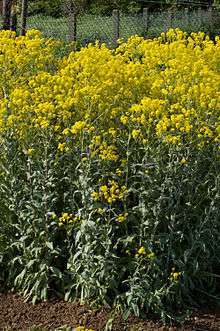Definify.com
Webster 1913 Edition
Woad
Woad
,Noun.
[OE.
wod
, AS. wād
; akin to D. weede
, G. waid
, OHG. weit
, Dan. vaid
, veid
, Sw. veide
, L. vitrum
.] [Written also
wad
, and wade
.] 1.
(Bot.)
An herbaceous cruciferous plant (
Isatis tinctoria
) of the family Cruciferae
(syn. Brassicaceae
). It was formerly cultivated for the blue coloring matter derived from its leaves. See isatin
. 2.
A blue dyestuff, or coloring matter, consisting of the powdered and fermented leaves of the
Isatis tinctoria
. It is now superseded by indigo, but is somewhat used with indigo as a ferment in dyeing. Their bodies . . . painted with
woad
in sundry figures. Milton.
Wild woad
(Bot.)
, the weld (
– Reseda luteola
). See Weld
. Woad mill
, a mill grinding and preparing woad.
Webster 1828 Edition
Woad
WOAD
,Noun.
Definition 2025
woad
woad
English

Woad (Isatis tinctoria)
Woad (dye)
Noun
woad (usually uncountable, plural woads)
- The plant Isatis tinctoria.
- 1840, Francis S. Wiggins, The American Farmer's Instructor, Or Practical Agriculturist, page 185,
- Woad is one of those plants which yield the deep blue colouring matter so greatly valued in the arts — Indigo.
- 1997, Joan Thirsk, Alternative Agriculture: A History, page 80,
- Woad was then placed on the regular shopping list of alternative crops.
- 1998, Daniel C. Beaver, Parish Communities and Religious Conflict in the Vale of Gloucester, 1590-1690, page 32,
- The cultivation of woad had taken hold in southern England during the early 1580s, but this dispute provides the earliest evidence of its cultivation in the fields around Tewkesbury.
- 1840, Francis S. Wiggins, The American Farmer's Instructor, Or Practical Agriculturist, page 185,
- The blue dye made from the leaves of the plant.
- 1814, Robert Henry, The History of Great Britain Volume XII, 5th Edition, page 309,
- To prevent this, it was enacted, that no wines of Gaſcony and Guienne, or woads of Tholouſe, should be imported into England, except in ships belonging to the King, or some of his ſubjects; and that all ſuch wines and woads imported in foreign bottoms ſhould be forfeited.
- 1856, Albrecht Daniel Thaer, The Principles of Practical Agriculture, page 462,
- But in the middle of the sixteenth century indigo was introduced from the East Indies: and in the seventeenth century its use became extended, and supplanted that of woad.
- 1983, E. B. Fryde, Studies in Medieval Trade and Finance, page 360,
- Huge quanitities of alum and woad were disembarked each year at Southampton.
- 2007, Richard L. Myers, The 100 Most Important Chemical Compounds: A Reference Guide, page 152,
- For example, woad, a blue dye obtained from the plant Isatis tinctoria, was used throughout the Mediterannean and Europe and is often identified as indigo.
- 1814, Robert Henry, The History of Great Britain Volume XII, 5th Edition, page 309,
Synonyms
Related terms
Translations
Isatis tinctoria
|
Verb
woad (third-person singular simple present woads, present participle woading, simple past and past participle woaded)
- To plant or cultivate woad.
- 1771, Arthur Young, The Farmer's Tour through the East of England, page 59,
- Now as the tenants after woading, pay the ſame rent as before, one cannot wonder at landlords making use of such an easy method to raise money: but it is the tenants that quarrel most at it; they assert the land to be 7 sg. an acre the worse for it; here then lies the enquiry.
- 1968, Eric Kerridge, The Agricultural Revolution, page 209,
- Such land was usually woaded for two, three or four years and then corned, […] .
- 1812, Edmund Burke, The Annual Register, Or, A View of the History, Politics, and Literature, For the Year 1811, page 517,
- He planted woad on it, and engaged a person from the north to manage it; and the produce was so abundant as to afford immense profit. I believe he only woaded two years, and then let it.
- 1771, Arthur Young, The Farmer's Tour through the East of England, page 59,
- To dye with woad.
- 1777, George Clark, The Penal Statutes Abridged, and Alphabetically Arranged, page 111,
- All woollen goods truly mathered, ſhall be marked with a red roſe, and a blue roſe, and all ſuch truly woaded throughout, with a blue roſe only; and if any perſon shall affix any ſuch mark falsely, he ſhall forfeit, for every piece ſo marked 4l. (ſee under).
- 1793, Charles Viner, A General Abridgment of Law and Equity, Volume 14, page 409,
- Againſt a dyer for woading his cloth only to the third ſtall (whereas the custom of dyers was to woad it to the fourth ſtall) and then marking it with the company's seal as if it had been woaded to the fourth ſtall; he was found guilty of woading it only to the third ſtall, and not of ſetting ſuch mark to it, for which reaſon the court was of opinion no judgement ought to be againſt the defendant.
- 1809, Charles Henry Hunt, A Practical Treatise on the Merino and Anglo-Merino Breeds of Sheep, page 64,
- This wool, when scowered, weighed 50 lbs.; when woaded blue, and picked, 48 lbs.
- 1777, George Clark, The Penal Statutes Abridged, and Alphabetically Arranged, page 111,